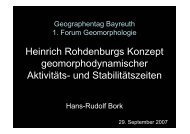Chapter 14 - Limitations on Predictive Modeling in Geomorphology ...
Chapter 14 - Limitations on Predictive Modeling in Geomorphology ...
Chapter 14 - Limitations on Predictive Modeling in Geomorphology ...
Create successful ePaper yourself
Turn your PDF publications into a flip-book with our unique Google optimized e-Paper software.
LIMITATIONS ON PREDICTIVE MODELING 343<br />
discharge c<strong>on</strong>diti<strong>on</strong>s ought to be best known. Use of such models as the basis for predicti<strong>on</strong><br />
<strong>in</strong> large-scale applicati<strong>on</strong>s is even more problematic. Moreover, the models<br />
themselves represent <strong>on</strong>ly <strong>on</strong>e of a number of sources of uncerta<strong>in</strong>ty <strong>in</strong> model<strong>in</strong>g sediment<br />
transport <strong>in</strong> large-scale systems, and not necessarily the most important source.<br />
C<strong>on</strong>sequently, attempts to reduce model imperfecti<strong>on</strong> by <strong>in</strong>troducti<strong>on</strong> of an 'improved'<br />
small-scale sediment transport 'formula' are likely to be of <strong>on</strong>ly limited effectiveness <strong>in</strong><br />
improv<strong>in</strong>g <strong>on</strong>e's ability to predict at the large scale. Predicti<strong>on</strong> and understand<strong>in</strong>g at a<br />
small scale, <strong>on</strong> the other hand, may well benefit from ref<strong>in</strong>ement and development of<br />
small-scale models.<br />
OMISSION OF SIGNIFICANT PROCESSES<br />
Incremental improvement of small-scale models of erosi<strong>on</strong> and depositi<strong>on</strong> cannot correct<br />
the defect of omitt<strong>in</strong>g significant physical processes. The larger the spatial scale of the<br />
envir<strong>on</strong>mental system and the l<strong>on</strong>ger the time scale of <strong>in</strong>terest, the greater is the chance<br />
that more than <strong>on</strong>e important process will be present. In their m<strong>on</strong>ograph <strong>on</strong> large-scale<br />
simulati<strong>on</strong> of elastic sediment transport, Tetzlaff and Harbaugh (1989) employ a fluvial<br />
picture of sediment erosi<strong>on</strong> and depositi<strong>on</strong>. They solve depth-averaged equati<strong>on</strong>s for water<br />
velocity over a given topographic surface, <strong>in</strong>voke a sediment transport model (similar to<br />
the Meyer-Peter and Muller bedload formula (1948) used <strong>in</strong> river sedimentati<strong>on</strong> studies),<br />
pass sediment from <strong>on</strong>e cell to another, and follow the evoluti<strong>on</strong> of topography. One<br />
possible applicati<strong>on</strong> of such models is to alluvial fan build<strong>in</strong>g (Tetzlaff and Harbaugh<br />
1989). However, alluvial fans may develop <strong>in</strong> the presence of n<strong>on</strong>fluvial transport<br />
mechanisms. In a given locati<strong>on</strong>, fluvial processes may dom<strong>in</strong>ate fan c<strong>on</strong>structi<strong>on</strong>, but<br />
elsewhere debris flows may be important c<strong>on</strong>tributors to the fan build<strong>in</strong>g process (e.g.<br />
Whipple and Dunne 1992). Debris flows can c<strong>on</strong>ta<strong>in</strong> up to 80-90% solids c<strong>on</strong>centrati<strong>on</strong><br />
Figure<str<strong>on</strong>g>14</str<strong>on</strong>g>.3 Bedload normally is composed of a th<strong>in</strong> carpet of sediment driven forward by the flow<br />
of the overly<strong>in</strong>g water, top panel. Debris flows, whose rheology is similar to that of a B<strong>in</strong>gham<br />
plastic, are comprised of an <strong>in</strong>timate mixture of poorly sorted elastic particles and water, with water<br />
c<strong>on</strong>tent as low as 10%, bottom panel








